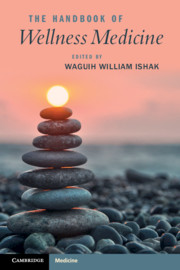Book contents
- The Handbook of Wellness Medicine
- The Handbook of Wellness Medicine
- Copyright page
- Dedication
- Contents
- Contributors
- Part I Approach to Wellness
- Chapter 1 Defining Wellness
- Chapter 2 Screening and Assessment Methods for Wellness
- Chapter 3 The Biopsychosocial Assessment
- Chapter 4 Wellness Measurement
- Chapter 5 The Wellness Treatment Plan
- Part II From Illness to Wellness by Organ Systems/Disorders
- Part III Special Populations and Special Topics
- Part IV Wellness Interventions
- Part V Wellness through Optimization of Work, Love, and Play
- Book part
- Index
- References
Chapter 2 - Screening and Assessment Methods for Wellness
from Part I - Approach to Wellness
Published online by Cambridge University Press: 18 September 2020
- The Handbook of Wellness Medicine
- The Handbook of Wellness Medicine
- Copyright page
- Dedication
- Contents
- Contributors
- Part I Approach to Wellness
- Chapter 1 Defining Wellness
- Chapter 2 Screening and Assessment Methods for Wellness
- Chapter 3 The Biopsychosocial Assessment
- Chapter 4 Wellness Measurement
- Chapter 5 The Wellness Treatment Plan
- Part II From Illness to Wellness by Organ Systems/Disorders
- Part III Special Populations and Special Topics
- Part IV Wellness Interventions
- Part V Wellness through Optimization of Work, Love, and Play
- Book part
- Index
- References
Summary
There are multiple movements within medicine, public health, and health policy that have expanded the measurement of well-being and wellness and made such practices imperative. Medicine continues to grow more highly specialized and focused on biomedical treatments. Physicians’ roles have become more siloed, and our knowledge of the effects of illness and medical treatments on patients’ lives is limited. Simultaneously, public health research has elucidated the importance of contexts, connectedness, and functioning to health. Biomedical treatments and the absence of illness do not define health. Well-being, social connectedness, and one’s ability to function in essential domains of life are essential components of health. In response, health policy has begun to prioritize patient-reported outcomes, including well-being and health-related quality of life (QOL).
- Type
- Chapter
- Information
- The Handbook of Wellness Medicine , pp. 13 - 22Publisher: Cambridge University PressPrint publication year: 2020



